NVIDIA’s GeForce GTX Titan Review, Part 2: Titan's Performance Unveiled
by Ryan Smith & Rahul Garg on February 21, 2013 9:00 AM ESTPower, Temperature, & Noise
Last but certainly not least, we have our obligatory look at power, temperature, and noise. Next to price and performance of course, these are some of the most important aspects of a GPU, due in large part to the impact of noise. All things considered, a loud card is undesirable unless there’s a sufficiently good reason to ignore the noise.
It’s for that reason that GPU manufacturers also seek to keep power usage down, and under normal circumstances there’s a pretty clear relationship between power consumption, heat generated, and the amount of noise the fans will generate to remove that heat. At the same time however this is an area that NVIDIA is focusing on for Titan, as a premium product means they can use premium materials, going above and beyond what more traditional plastic cards can do for noise dampening.
| GeForce GTX Titan Voltages | ||||
| Titan Max Boost | Titan Base | Titan Idle | ||
| 1.1625v | 1.012v | 0.875v | ||
Stopping quickly to take a look at voltages, Titan’s peak stock voltage is at 1.162v, which correlates to its highest speed bin of 992MHz. As the clockspeeds go farther down these voltages drop, to a load low of 0.95v at 744MHz. This ends up being a bit less than the GTX 680 and most other desktop Kepler cards, which go up just a bit higher to 1.175v. Since NVIDIA is classifying 1.175v as an “overvoltage” on Titan, it looks like GK110 isn’t going to be quite as tolerant of voltages as GK104 was.
| GeForce GTX Titan Average Clockspeeds | |||
| Max Boost Clock | 992MHz | ||
| DiRT:S | 992MHz | ||
| Shogun 2 | 966MHz | ||
| Hitman | 992MHz | ||
| Sleeping Dogs | 966MHz | ||
| Crysis | 992MHz | ||
| Far Cry 3 | 979MHz | ||
| Battlefield 3 | 992MHz | ||
| Civilization V | 979MHz | ||
One thing we quickly notice about Titan is that thanks to GPU Boost 2 and the shift from what was primarily a power based boost system to a temperature based boost system is that Titan hits its maximum speed bin far more often and sustains it more often too, especially since there’s no longer a concept of a power target with Titan, and any power limits are based entirely by TDP. Half of our games have an average clockspeed of 992MHz, or in other words never triggered a power or thermal condition that would require Titan to scale back its clockspeed. For the rest of our tests the worst clockspeed was all of 2 bins (26MHz) lower at 966MHz, with this being a mix of hitting both thermal and power limits.
On a side note, it’s worth pointing out that these are well in excess of NVIDIA’s official boost clock for Titan. With Titan boost bins being based almost entirely on temperature, the average boost speed for Titan is going to be more dependent on environment (intake) temperatures than GTX 680 was, so our numbers are almost certainly a bit higher than what one would see in a hotter environment.
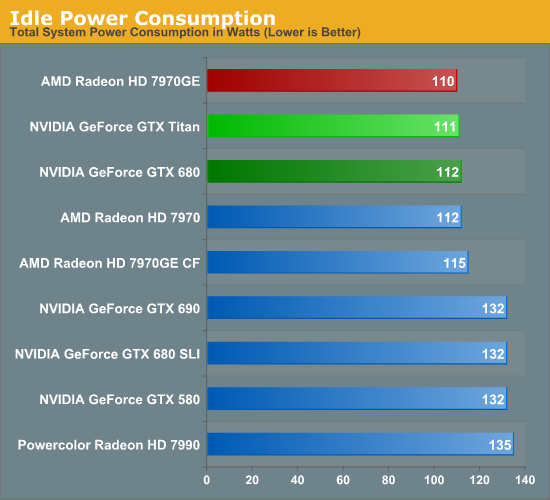
Starting as always with a look at power, there’s nothing particularly out of the ordinary here. AMD and NVIDIA have become very good at managing idle power through power gating and other techniques, and as a result idle power has come down by leaps and bounds over the years. At this point we still typically see some correlation between die size and idle power, but that’s a few watts at best. So at 111W at the wall, Titan is up there with the best cards.
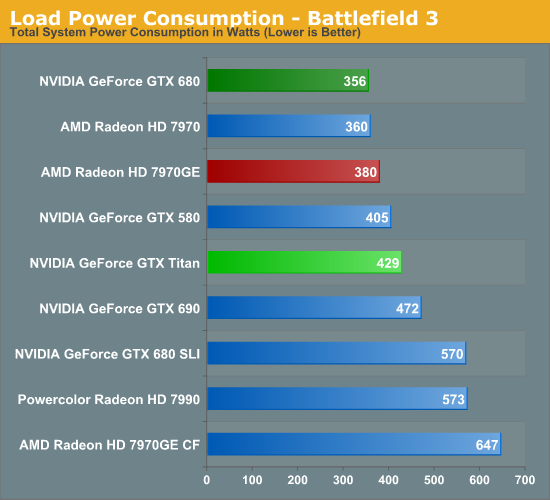
Moving on to our first load power measurement, as we’ve dropped Metro 2033 from our benchmark suite we’ve replaced it with Battlefield 3 as our game of choice for measuring peak gaming power consumption. BF3 is a difficult game to run, but overall it presents a rather typical power profile which of all the games in our benchmark suite makes it one of the best representatives.
In any case, as we can see Titan’s power consumption comes in below all of our multi-GPU configurations, but higher than any other single-GPU card. Titan’s 250W TDP is 55W higher than GTX 680’s 195W TDP, and with a 73W difference at the wall this isn’t too far off. A bit more surprising is that it’s drawing nearly 50W more than our 7970GE at the wall, given the fact that we know the 7970GE usually gets close to its TDP of 250W. At the same time since this is a live game benchmark, there are more factors than just the GPU in play. Generally speaking, the higher a card’s performance here, the harder the rest of the system will have to work to keep said card fed, which further increases power consumption at the wall.
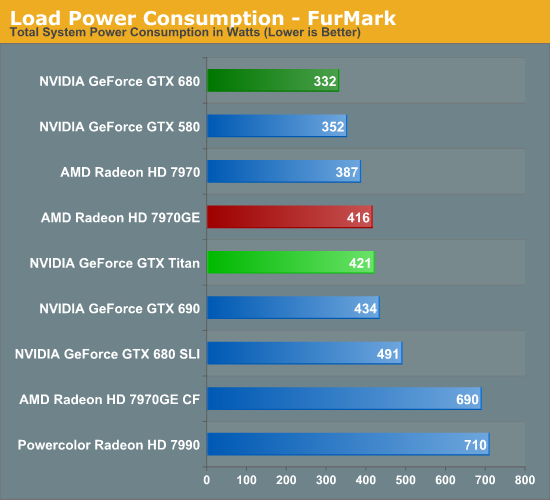
Moving to Furmark our results keep the same order, but the gap between the GTX 680 and Titan widens, while the gap between Titan and the 7970GE narrows. Titan and the 7970GE shouldn’t be too far apart from each other in most situations due to their similar TDPs (even if NVIDIA and AMD TDPs aren’t calculated in quite the same way), so in a pure GPU power consumption scenario this is what we would expect to see.
Titan for its part is the traditional big NVIDIA GPU, and while NVIDIA does what they can to keep it in check, at the end of the day it’s still going to be among the more power hungry cards in our collection. Power consumption itself isn’t generally a problem with these high end cards so long as a system has the means to cool it and doesn’t generate much noise in doing so.
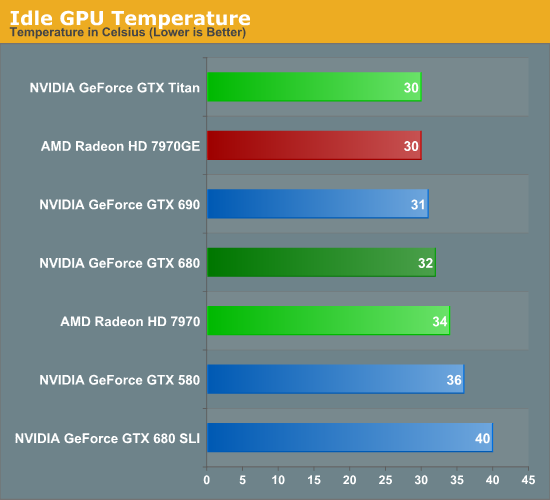
Moving on to temperatures, for a single card idle temperatures should be under 40C for anything with at least a decent cooler. Titan for its part is among the coolest at 30C; its large heatsink combined with its relatively low idle power consumption makes it easy to cool here.
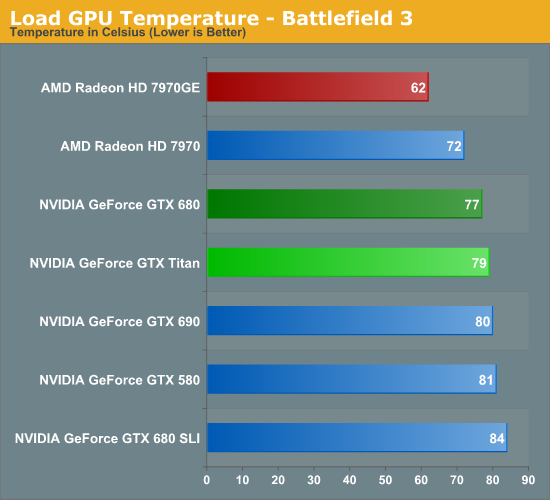
Because Titan’s boost mechanisms are now temperature based, Titan’s temperatures are going to naturally gravitate towards its default temperature target of 80C as the card raises and lowers clockspeeds to maximize performance while keeping temperatures at or under that level. As a result just about any heavy load is going to see Titan within a couple of degrees of 80C, which makes for some very predictable results.
Looking at our other cards, while the various NVIDIA cards are still close in performance the 7970GE ends up being quite a bit cooler due to its open air cooler. This is typical of what we see with good open air coolers, though with NVIDIA’s temperature based boost system I’m left wondering if perhaps those days are numbered. So long as 80C is a safe temperature, there’s little reason not to gravitate towards it with a system like NVIDIA’s, regardless of the cooler used.
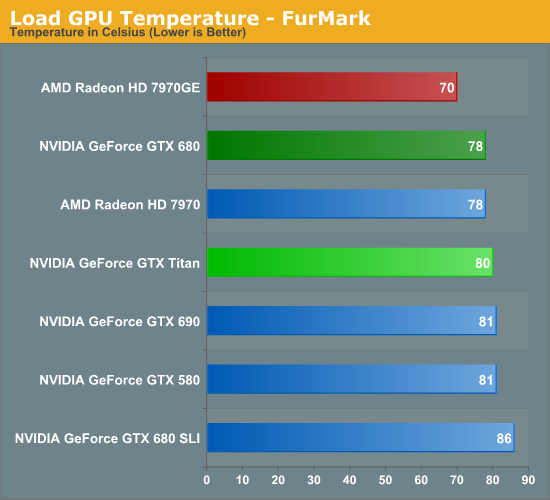
With Furmark we see everything pull closer together as Titan holds fast at 80C while most of the other cards, especially the Radeons, rise in temperature. At this point Titan is clearly cooler than a GTX 680 SLI, 2C warmer than a single GTX 680, and still a good 10C warmer than our 7970GE.

Just as with the GTX 690, one of the things NVIDIA focused on was construction choices and materials to reduce noise generated. So long as you can keep noise down, then for the most part power consumption and temperatures don’t matter.
Simply looking at idle shows that NVIDIA is capable of delivering on their claims. 37.8dB is the quietest actively cooled high-end card we’ve measured yet, besting even the luxury GTX 690, and the also well-constructed GTX 680. Though really with the loudest setup being all of 40.5dB, none of these setups is anywhere near loud at idle.
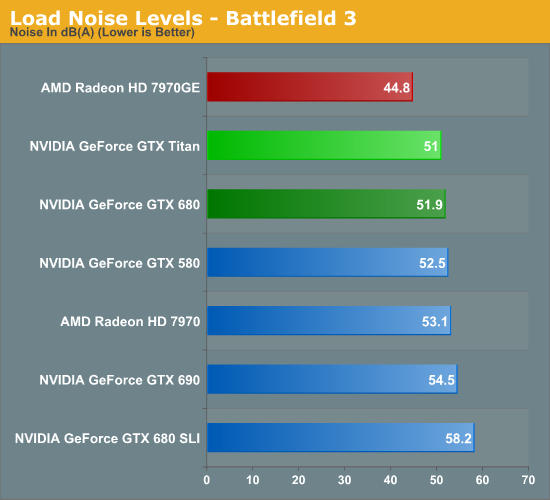
It’s with load noise that we finally see the full payoff of Titan’s build quality. At 51dB it’s only marginally quieter than the GTX 680, but as we recall from our earlier power data, Titan is drawing nearly 70W more than GTX 680 at the wall. In other words, despite the fact that Titan is drawing significantly more power than GTX 680, it’s still as quiet as or quieter than the aforementioned card. This coupled with Titan’s already high performance is Titan’s true power in NVIDIA’s eyes; it’s not just fast, but despite its speed and despite its TDP it’s as quiet as any other blower based card out there, allowing them to get away with things such as Tiki and tri-SLI systems with reasonable noise levels.
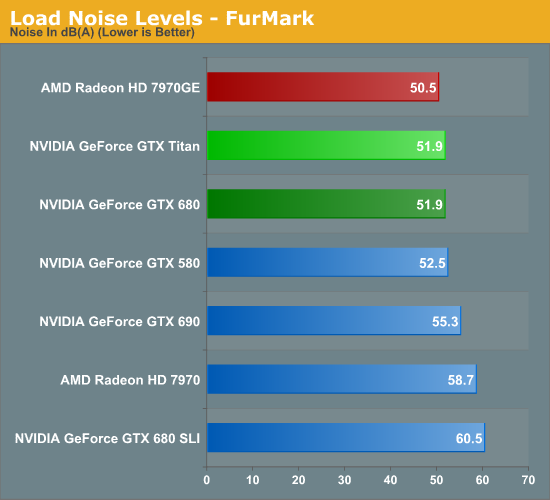
Much like what we saw with temperatures under Furmark, noise under Furmark has our single-GPU cards bunching up. Titan goes up just enough to tie GTX 680 in our pathological scenario, meanwhile our multi-GPU cards start shooting up well past Titan, while the 7970GE jumps up to just shy of Titan. This is a worst case scenario, but it’s a good example of how GPU Boost 2.0’s temperature functionality means that Titan quite literally keeps its cool and thereby keeps its noise in check.
Of course we would be remiss to point out that in all these scenarios the open air cooled 7970GE is still quieter, and in our gaming scenario by actually by quite a bit. Not that Titan is loud, but it doesn’t compare to the 7970GE. Ultimately we get to the age old debate between blowers and open air coolers; open air coolers are generally quieter, but blowers allow for more flexibility with products, and are more lenient with cases with poor airflow.
Ultimately Titan is a blower so that NVIDIA can do concept PCs like Tiki, which is something an open air cooler would never be suitable for. For DIY builders the benefits may not be as pronounced, but this is also why NVIDIA is focusing so heavily on boutique systems where the space difference really matters. Whereas realistically speaking, AMD’s best blower-capable card is the vanilla 7970, a less power hungry but also much less powerful card.










337 Comments
View All Comments
PEJUman - Thursday, February 21, 2013 - link
Made me wonder:7970 - 4.3B trans. - $500 - OK compute, 100% gaming perf.
680 - 3.5B trans. _ $500 - sucky compute, 100% gaming perf.
Titan - 7.1B trans - $1000 - OK compute, ~140% gaming perf.
1. Does compute capability really takes that much more transistors to build? as in 2x trans. only yield ~140% improvement on gaming.
I think this was a conscious decision by nVidia to focus on compute and the required profit margin to sustain R&D.
2. despite the die size shrink, I'm guessing it would be harder to have functional silicon as the process shrinks. i.e. finding 100mm^2 of functional silicon @ 40nm is easier than @28nm, from the standpoint that more transistors are packed to the same area. Which I think why they have 15SMXs designed.
Thus it'd be more expensive for nVidia to build same area at 28 vs. 40 nm... at least until the process matures, but at 7B I doubt it will ever be attainable.
3. The AMD statement on no updates to 7970 essentially sealed the $1000 price for titan. I would bet if AMD announced 8970, Titan would be priced at $700 today, with 3GB memory.
JarredWalton - Thursday, February 21, 2013 - link
Luxury GPU is no more silly than Extreme CPUs that cost $1000 each. And yet, Intel continues to sell those, and what's more the performance offered by Titan is a far better deal than the performance offered by a $1000 CPU vs. a $500 CPU. Then there's the Tesla argument: it's a $3500 card for the K20 and this is less than a third that price, with the only drawbacks being no ECC and no scalability beyond three cards. For the Quadro crowd, this might be a bargain at $1000 (though I suspect Titan won't get the enhanced Quadro drivers, so it's mostly a compute Tesla alternative).chizow - Friday, February 22, 2013 - link
The problem with this analogy, which I'm sure was floated around Nvidia's Marketing board room in formulating the plan for Titan, is that Intel offers viable alternative SKUs based on the same ASIC. Sure there are the few who will buy the Intel EE CPU (3970K) for $1K, but the overwhelming majority in that high-end market would rather opt for the $500 option (3930K) or $300 option (3820).Extend this to the GPU market and you see Nvidia clearly withheld GK100/GK110 as the flagship part for over a year, and instead of offering a viable SKU for traditional high-end market segments based on this ASIC, they created a NEW ultra-premium market. That's the ONLY reason Titan looks better compared to GK104 than Intel's $1K and $500 options, because Nvidia's offerings are truly different classes while Intel's differences are minor binning and multiplier locked parts with a bigger black box.
mlambert890 - Saturday, February 23, 2013 - link
The analogy is fine, you're just choosing to not see it.Everything you said about Intel EE vs standard directly applies here.
You are assuming that the Intel EE parts are nothing more than a marketing ploy, which is wrong, while at the same time assuming that the Titan is orders of magnitude beyond the 680 which is also wrong.
You're seeing it from the point of view of someone who buys the cheapest Intel CPU, overclocks it to the point of melting, and then feels they have a solution "just as good if not better" than the Intel EE.
Because the Titan has unlocked stream procs that the 680 lacks, and there is no way to "overclock" your way around missing SPs, you feel that NVidia has committed some great sin.
The reality is that the EE procs give out of box performance that is superior to out of box performance of the lesser SKUs by a small, but appreciable, margin. In addition, they are unlocked, and come from a better bin, which means they will overclock *even better* than the lesser SKUs. Budget buyers never want to admit this, but it is reality in most cases. Yes you can get a "lucky part" from the lesser SKU that achieves a 100% overclock, but this is an anomaly. Most who criticize the EE SKUs have never even come close to owning one.
Similarly, the Titan offers a small, but appreciable, margin of performance over the 680. It allows you to wait longer before going SLI. The only difference is you don't get the "roll of the dice" shot at a 680 that *might* be able to appear to match a Titan since the SP's arent there.
The analogy is fine, it's just that biased perspective prevents some from seeing it.
chizow - Saturday, February 23, 2013 - link
Well you obviously have trouble comprehending analogies if you think 3.6B difference in transistors and ~40% difference in performance is analogous to 3MB L3 cache, an unlocked multiplier and 5% difference in performance.But I guess that's the only way you could draw such an asinine parallel as this:
"Similarly, the Titan offers a small, but appreciable, margin of performance over the 680."
It's the only way your ridiculous analogy to Intel's EE could possibly hold true, when in reality, it couldn't be further from the truth. Titan holds a huge advantage over GTX 680, but that's expected, its a completely different class of GPU whereas the 3930K and 3960X are cut from the exact same wafer.
CeriseCogburn - Sunday, February 24, 2013 - link
There was no manufacturing capacity you IDIOT LIAR.The 680 came out 6 months late, and amd BARELY had 79xx's on the shelves till a day before that.
Articles were everywhere pointing out nVidia did not have reserve die space as the crunch was extreme, and the ONLY factory was in the process of doing a multi-billion dollar build out to try to keep up with bare minimum demand.
Now we've got a giant GPU core with perhaps 100 attempted dies per wafer, with a not high yield, YET YOU'RE A LIAR NONETHELESS.
chizow - Sunday, February 24, 2013 - link
It has nothing to do with manufacturing capacity, it had everything to do with 7970's lackluster performance and high price tag.GTX 680 was only late (by 3, not 6 months) because Nvidia was too busy re-formulating their high-end strategy after seeing 7970 outperform GTX 580 by only 15-20% but asking 10% higher price. Horrible price:performance metric for a new generation GPU on a new process node.
This gave Nvidia the opportunity to:
1) Position mid-range ASIC GK104 as flagship GTX 680 and still beat the 7970.
2) Push back and most importantly, re-spin GK100 and refine it to be GK110.
3) Screw their long-time customers and AMD/AMD fans in the process.
4) Profit.
So instead of launching and mass-producing their flagship ASIC first (GK100) as they've done in every single previous generation and product launch, they shifted their production allocation at TSMC to their mid-range ASIC, GK104 instead.
Once GK110 was ready, they've had no problem churning them out, even the mfg date of these TITAN prove this point as week 31 chips are somewhere in the July-August time frame. They were able to deliver some 19,000 K20X units to ORNL for the real TITAN in October 2012. Coupled with the fact they're using ASICs with the same number of functional units for GTX Titanic, it goes to show yields are pretty good.
But the real conclusion to be drawn for this is that other SKUs based on GK110 are coming. There's no way GK110 wafer yields are anywhere close to 100% for 15 SMX ASICs. I fully expect a reduced SMX unit, maybe 13 with 2304SP as originally rumored show it's face as the GTX 780 with a bunch of GK114 refreshes behind it to fill out the line-up.
The sooner people stop overpaying for TITAN, the sooner we'll see the GTX 700 series, imo, but with no new AMD GPUs on the horizon we may be waiting awhile.
CeriseCogburn - Sunday, February 24, 2013 - link
Chizow I didn't read your stupid long post except for your stupid 1st line.you're a brainwashed lying sack of idiocy, so maybe i'll waste my time reading your idiotic lies, and maybe not, since your first line is the big fat frikkin LIE you HAVE TO BELIEVE that you made up in your frikkin head, in order to take your absolutely FALSE STANCE for the past frikkin nearly year now.
chizow - Monday, February 25, 2013 - link
You should read it, you might learn something.Until then stfd, stfu, and gfy.
CeriseCogburn - Sunday, February 24, 2013 - link
Dear Jeff, a GPU that costs $400 dollars is a luxury GPU.I'm not certain you disagree with that, I'd just like to point out the brainless idiots pretending $1000 for a GPU is luxury and $250 is not are clueless.